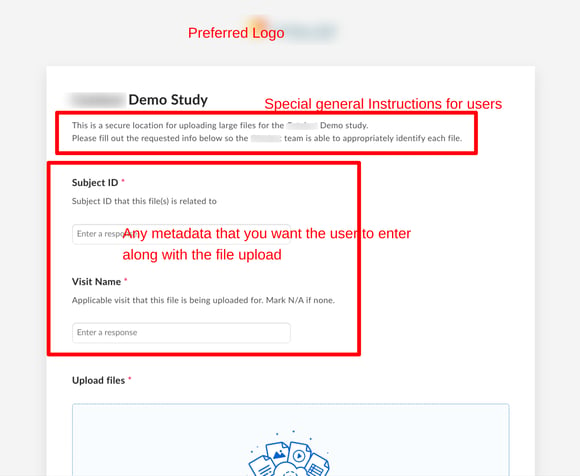How to Include Files or Media Fields in Forms
Forms can be built to collect any file type, including images and video. This is done by using any of the following form objects in the form builder.
Images and video fields are typically used when media needs to be collected real-time during data entry. For example, a Participant filling out a form and taking a photo of the study device or substance they received in the mail. Images and video taken natively on the mobile app will be stored as .jpg and .mpeg files respectively.
Alternatively, files that exist already (collected in the past) can be uploaded on a form via a file upload field. This includes any type or format or file.
Accessing and Viewing Files
As files get collected throughout the various forms on which they are collected, the file repository is a good way to centrally access all of those files. This is usually a preferred alternative to accessing the files directly on the forms/records where they were collected.
Files can be opened and viewed directly within the web browser or mobile app to prevent the need for downloading the file locally.
Downloading files from a form is unavailable by default to prevent files from being transferred to local computers. However, anyone with access to the file repository is able to download the files for fields they have access to (field blinding enforced).
TrialKit Drop with Box
For studies or projects that require large files, such as high resolution images or videos, to be uploaded, upload fields on forms are not an ideal approach. For this reason, CDS offers a separate solution, TrialKit Drop, that serves the purpose of gathering large files from users.
It's accessed by a URL directly on any form. Here's an example:

That link then opens a common secure study-specific Box file location for the user to upload their file(s). The file drop location can contain custom content as shown here:
FAQ
What file formats does TrialKit support?
Any file format can be uploaded on a file upload field.
What size of files can be uploaded
We recommend under 500mb to prevent a high waiting period for the file to load. However, it will be possible to go as high as 750mb before session timeout issues start to occur on web browsers.
Consider the use of TrialKit Drop tool if your project requires larger file sizes to be uploaded and stored.
Are dicoms supported?
Yes, the dicom format can be uploaded and stored, but have a greater potential of running into storage limitations due to the inherent file size. Dicoms come in different shapes and sizes so the storage limitations within TrialKit depend on the size of the images.
For example, if a study is only collecting flat dicom files such as radiographic images, that will not be a problem because those can be as small as 200KB and average of 30MB. On the other hand, large WSI dicoms like CT scans can be as much as 15GB per file - which not only require isolated storage capabilities, but also a streaming service to present and work with the images real time over the web.
It's also worth noting that dicom viewing is not natively supported within TrialKit. Users who need to view and analyze dicom metadata will need to download the dicom first to their computer to use an external viewing tool.

